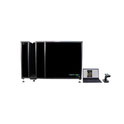Growth Pouches for High-Throughput Root Phenotyping
Growth pouch systems, using plants grown vertically on germination paper, are suitable for phenotyping root system architectures (RSA) of large numbers of seedlings in a rapid and cost-effective manner - enabling high-throughput (HT) root phenotyping / screening approaches. Lengths, branching and angles of different root types can be measured, which form the basis of models to generate RSAs of crop genotypes and estimate soil exploration and resource uptake. Seed germination pouch systems have been successfully applied to root screens for many years and species - including beans, maize, wheat, oilseed rape, and pearl millet. The measurement of root traits such as seminal, nodal root numbers and root branching angles on growth pouch / germination paper pouches has shown to hold predictive value for breeding crops with greater yields and stress tolerance. Read more on the application potential of root pouches.
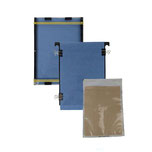
Vienna Scientific Instrument offers two different root pouches / germination pouch types:
- Growth pouch positioning system (classical, "low cost", plastic sleeve Type 1), &
- Growth pouches with rigid cover panel (Type 2),
Type 1: Cost-Effective Phenotyping Pouch "Positioning System"
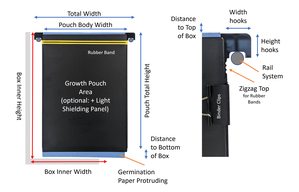
Growth Pouch "Type 1". In this cost-effective and efficient root phenotyping growth pouch system, a central acrylic plate (black) is used to hold two germination paper in plastic sleeves (on either site of the Positioning Panel). Hooks at the top of the acrylic panel allow hanging the root pouch system into storage containers/boxes with water/nutrient solution ("PhenoRacks"), allowing the germination paper to re-wet and providing a space effective and organized storage solution. Shading panels prevent light from reaching the roots. Please complete the Growth Pouch Type 1 configuration form (pdf) below for custom root pouch designs, get an instant quote for standard root growth pouch sets (see below), or buy pouch phenotyping sets online.
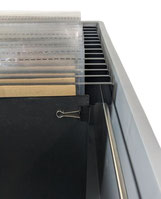
Growth Pouch "Type 1" Sets. Two standard sizes of Root Pouches (Type 1) and custom dimensions are available. In the sets, 20-30 Pouch Positioning Panels are placed in a storage container equipped with a rail system (see figure; read more: Pouch PhenoRacks). Growth Pouches can be placed on either side of the central acrylic (black, 4mm) positioning panels. Shading panels (1mm, black) fit snugly over the outer surfaces of the pouches; they are slightly narrower to avoid tension at the sides and shorter to match the height of the seed position. Two fixing systems can be used to attach the growth pouches & shading panels to the positioning system, 'rubber bands' or office binder clips (see illustrations). The Positioning Plates have a special zigzag pattern on the top to hold the rubber bands securely in place. When hanging, the position plates are spaced ~1 cm apart (to avoid disturbing/crushing roots). If desired, germination papers can be tapped into the water/nutrient solution at the bottom of the PhenoRacks, or, when using closed plastic sleeves, a small amount of water/nutrient solution can be stored at the bottom of each pouch.
Growth Pouch Type 1 - Features
- Standardized experimentation with growth and germination pouches
- Flexible, for hanging and standing pouch storage solutions
- Fitting light exclusion panels
- Fully customized - made to fit your experimental system - and standard sizes
Options:
- Ready to use, sterile germination pouches - 3 sizes
- Fitting set-up and manipulation stands
SET 1 (22.5 x 30 cm)
The "Type 1" Set 1 (suitable for A4 size germination paper) contains:
- Storage Container (ID: 37 x 27 x 31.5 cm, LxWxH)
- Rails (stainless steel, 6 mm)
- 20x Pouch Positioning Panels (Body area: 22.5 cm width, 30 cm height)
- 40x Light Shielding Panels (22x28 cm)
SET 2 (29 x 38 cm)
The "Type 1" Set 2 (suitable for e.g. 10 x 15 inch growth paper, large seed germination Pouches PTC-GP-30) contains:
- Storage Container (ID: 57 x 37 x 41.5 cm, LxWxH)
- Rails (stainless steel, 8 mm)
- 30x Pouch Positioning Panels (Body area: 29 cm width, 38 cm height)
- 60x Light Shielding Panels (28x34 cm)
For Custom designs please send per email: Growth Pouch Type 1 Configuration form (pdf, above). Buy Standard Positioning Panel sizes online in sets of 10.
Type 2: Rigid Root Growth Pouch System with Acrylic Cover Plates and Spacers

Rigid Growth Pouch "Type 2". Some researchers use growing paper-based root pouch systems with acrylic front panels and spacers to enclose the germination paper and developing root system. Here, a system frequently used for corn root phenotyping is exemplified, using three to four layers of germination paper and 8-10 mm spacers - providing sufficient growing space (for large diameter roots), ventilation, and good mechanical protection for the developing root systems. A potentially enhanced version of this rigid root pouch system, providing some resistance to the growing root system, are root phenoboxes - with a spongy middle layer.
Rigid Growth Pouch "Type 2" Set. The standard size of these rigid root phenotyping pouches (Type 2) is 25 cm wide x 30.5 cm high - fitting 10 x 12 inch germination paper. Custom sizes are available. For example, ~20x "Type-2-pouches" can be placed in a 40 x 30 x 32 cm storage container (PhenoRack). Layers of germination paper can be placed between the acrylic (black) positioning panel (back) and a clear, transparent front panel with spacers attached (screws); standard space between panels is 8 mm (spacers) + germination paper layer thickness. The spacers can be (subsequently) changed by the customer to adapt the phenotyping system to other seed sizes / different numbers of germination papers as required (e.g. fitting 4mm or 10mm spacers). Germination papers are held securely in place by the front panels with spacers pressed against the back panels (using either office binders or rubber bands) - with the paper in between. Additional spacers at the centre top / bottom of pouches, preventing the paper from curling/corrugating, are optional (and can be positioned as discussed). A shading panel fits snugly over the transparent front panel of this root growth pouch type. The rear and front panels have a special zig-zag pattern to hold rubber bands securely in place. Optional cut-outs (1 x 0.5 cm) at the base of the back panel allow the system to stand in the storage container while the germination paper reliably tap into water or nutrient solution for rewetting.
The standard growth pouch "Type 2" Set (suitable for e.g. 10 x 12-15 inch germination paper) contains:
- Storage container (grey) for ~20 rigid root growth pouches
- 20x "Type 2"-rigid pouch sets, back and front each 30.5 cm (12 inch) high x 25 cm (10 inch) wide, 4 mm PMMA (Back: black, front: transparent), spacer height 8 mm (black, attached with screws to front panel on both longer sides, plus 1-4x 2 cm spacer sections (please indicate if and where to position; standard: no centre spacers)
- 20x shading panels, 28 cm high, 24.5 cm wide, 1 mm PMMA (black).
- Rubber bands
Consumables such as germination paper (e.g. from Anchor) and clear plastic sleeves ("office depot") can be sourced locally. Contact us to discuss seed germination pouch phenotyping systems (e.g. different pouch dimensions (sizes, height), storage solutions, etc.).
Growth Pouch Accessories

PhenoRacks, designed to provide space-efficient, protected and dark storage for Growth Pouches, hanging (Type 1) or standing (rigid Type 2) in sturdy storage containers with a rail or rack system. PhenoRacks hold 20-30 Root Growth Pouches (one-sided; 40-60 if using both sides of Type 1-positioning panels) depending on size. Continue reading on root PhenoRacks.
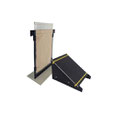
Pouch Manipulation Stands, 30° angled (from horizontal), or ~90° (nearly upright). In brief, the vertical growth pouch stand is used when root pouches are stored on hanging rails (PhenoRacks) and need to be removed from the containers for set-up, imaging and manipulation. The 30° angled stand (from horizontal, 60° from vertical) reduces the risk of damaging shoots - protruding from the top of pouches. The stand is thus used for placement during root sampling, imaging and manipulation. Continue reading on root growth pouch manipulation stands.
Application of Pouches for Phenotyping

- How are root pouches / germination paper-based root phenotyping systems generally used? While the exact procedure differs depending on the applied growth pouch system and plant species, in brief, seeds are placed on the wetted germination paper, or seeds are fixated between creped paper and acrylic plates, and then water or a liquid fertilizer solution is added to the bottom of storage containers or bottom sealed pouches. Usually, thick creped paper-types are used. Most seeds can be grown in growth pouch systems. In general, it is advisable to moisten the paper well before and after placing the seeds. Seeds of some species should be pre-germinated / soaked before being placed. Continue reading
-
Anyhow, eventually, the paper pouch is (en-)closed within a plastic sheet/envelope (growth pouch type "one") or acylic cover (growth pouch type "two") and the growth pouch is placed in an upright (90°) position - the protruding base of the germination paper often taps into a bottom reservoir of water or nutrient solution to re-moist. Alternatively, closed plastic envelopes hold a small water reservoir per plant - avoiding cross contamination but requiring more careful watering than bottom reservoirs. Seed germination pouch dimensions should be chosen according to the seed size, the expected root growth (depth and lateral) during the experimental period, and the germination paper-size available. Finally, all types of pouches should be covered by shading panels, dark plastic or aluminum foil and/or placed in darkend boxes etc. to prevent light reaching the root systems. It is important to work clean (i.e. towards sterile conditions; e.g. in a laminar flow cabinet) when preparing the seeds and pouches - as the system is, in the absence of natural antagonists in soil, prone to fungal and bacterial contamination. To minimize fungal growth, it may be helpful to surface sterilize seeds, and autoclave germination papers. Darkend root phenotyping pouches are placed under plant lamps or in growth chambers / rooms. Regularly, root systems are imaged with cameras/scanners or root growth and root architecture is measured manually; exposure to light should be as brief as possible.
Continue to read on how to study rhizobia / nodules in germination pouch phenotyping systems.
| References | Growth Pouches | OPEN |
|
||
See laboratory-ready, sterile pouches for soil and hassle-free root phenotyping and plant bioassays.
For an HT, soil-free root phenotyping platform providing some resistance to root growth, consider using Root-Phenoboxes.
The use of a matching adapter cassette for hanging (Type 1) or standing (Type 2) growth pouches allows using the "Rhizobox" Automated Imager to capture and register growth pouches.














